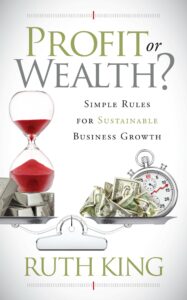Profit or Wealth
Many entrepreneurs and business owners are focused on profits. Ruth King argues that they must also consider the importance of building wealth or risk bankruptcy. Understanding financials and setting goals is key to building sustainable, long-term growth.
Ruth King has a passion for helping business achieve that lasting financial success. She started the Women’s Entrepreneurial Center and the Decatur, Georgia branch of the Small Business Development Center. She has appeared on numerous TV and radio stations. Her book, Profit or Wealth: Simple Rules for Sustainable Business Growth includes numerous helpful financial lessons for business owners. I reached out to talk about her book.
Tell us more about your mission to help businesses create sustainable growth.
My belief is that growth is necessary for business survival. There are two types of growth – revenue or top line growth and profits or bottom line growth.
If revenues remain flat profits decrease because costs go up every year (employees want raises, the cost of electricity increases, material costs increase, etc.) At some point profits become losses and the business is not sustainable.
A business must grow revenues at least the rate of inflation each year.
Bottom line, or profit growth is also necessary although it can flatten out at a certain percentage of revenues or a certain net profit per hour. There has to be a minimum net profit to cover required future costs such as capital equipment and purchases. Above this minimum, the company can sustain growth.
Imagine what would happen if every business were profitable. My mission is to enable this worldwide (it’s a mission larger than I am and can be sustained after I am no longer on this Earth). My writing, speaking, training, and consulting are all focused on helping business people get and stay profitable as well as build wealth.
3 Reasons Profitable Companies Go Broke
Why do profitable companies go broke? What should leaders be on the lookout to be sure this doesn’t happen?
Profitable companies go broke for three major reasons:
- A major customer goes bankrupt, doesn’t pay, or disputes the invoice and leaves the company with uncollectable receivables.
- The company grows so quickly that it runs out of cash.
- The company is drawn into a lawsuit (through no fault of their own) for profitable and correct work that was performed or someone getting hurt on a project.
And, in these times, there is a fourth:
The government shuts down all businesses with the exception of essential services.
Leaders must make sure the company has enough cash to survive potential crises. That cash must equal at least three to six months operating expenses.
Would you share with our readers one of your profit rules?
Profit Rule #1 – Live, Eat, and Breathe Net Profit Per Hour
Most business owners look at their profit and loss statements by looking at the percentages. They determine a good or bad month/year by that percentage.
For example: “Our company made a 10% net last year. Industry average is 5% net profit. We did really well.” Did you?
Percentages don’t tell the real story. You can’t take a percentage to the bank. The only thing you can take to the bank are dollars. When you manage your company’s operations by net profit per hour rather than percentages, you determine true cost and true profit.
If you track by net profit percentage, you’re fooling yourself. Why? The first thing you usually do is convert the percentage into dollars and decide whether those dollars are enough. You MUST dig deeper. What do those dollars represent? How many billable or revenue producing hours were used to create those dollars? Then, decide whether those dollars are enough.
 Jeremy and Josh meet at an industry conference. They start talking about their profits. They discover that each has a 10% net profit. Jeremy is a student of net profit per hour and explains it to Josh. Jeremy’s net profit per hour is $50 per hour. When Josh does his calculation his net profit per hour is only $10 per hour. Both have the same net profit percentage. Jeremy is 5 times more profitable than Josh.
Jeremy and Josh meet at an industry conference. They start talking about their profits. They discover that each has a 10% net profit. Jeremy is a student of net profit per hour and explains it to Josh. Jeremy’s net profit per hour is $50 per hour. When Josh does his calculation his net profit per hour is only $10 per hour. Both have the same net profit percentage. Jeremy is 5 times more profitable than Josh.
The percentages don’t matter. The profit dollars matter. The net profit per hour matters more.
What are some early warning signs that a company is becoming less profitable?
The major indicator is the current ratio (current assets divided by current liabilities – values are found on the balance sheet).
Most of the time an increasing current ratio means increasing profitability. A decreasing current ratio means decreasing profitability. If the current ratio is decreasing, the company is becoming less profitable. Find out why and fix it.
Let’s switch to wealth rules. Rule one is to “pay attention to your balance sheet.” Why is the balance sheet so often overlooked by leaders?
Most leaders think their profit and loss statement tells them how the company is performing. It does – only for a limited time (i.e. one month or one year). It doesn’t tell how the company is performing long term, i.e. is it headed in the right direction.
Leaders don’t realize that balance sheets are more important that Profit and Loss statements – a balance sheet tells a leader the true profitability of the company (see the answer to the “Why companies go broke” question).
Balance sheets tell leaders if they are heading for a cash problem, whether the company is building debt, if the company is headed for a collection problem, and whether it is building up too much inventory.
What are some ways to generate customer loyalty to encourage predictable revenue streams?
Monthly recurring revenue, loyalty programs, and membership programs, for example, tie customers to companies. This gives companies predictable cash flow.
Software companies do this through customers paying monthly for the software and support. Gyms, AT&T, Sprint, etc. do this through their phone and wireless sales.
There could be a book of the month (done in the past), cake of the month, tea of the month, etc. that gives loyal customers something to look forward to every month.
Heating and air conditioning contractors have maintenance programs that help homeowners and business owners take care of the HVAC systems. Pest control companies also have maintenance programs.
Loyalty programs create predictable revenue streams.
Create one by looking at what customers have repeatedly purchased. What additional benefits can you provide? What are the costs? Recurring revenue programs should be profitable.
What are some key things to watch during the pandemic? How do leaders focus on the long-term even as they are trying to survive?
Leaders must watch cash. Cash is critical to survival. That means collecting on time (or have customers pay COD).
Profitable sales, when collected, lead to positive cash flow. Make sure that all products are profitable. If not, decide whether the company should produce the product or provide that service.
Overhead (i.e. support employees) must understand how they fit into the profitability picture. Ask them how to save $100 a month. They’ll have the answers. Implement those suggestions whenever possible.
During this strange time, what are the top three recommendations you find yourself making over and over to business owners?
- Put 1% to 2% of every revenue dollar you receive in a savings account. (This should be done all the time – not just in this strange time)
- Review all proposals and quotes even if they are a year old. Contact the people you gave the proposals and quotes to. Find out if they bought yet. You might get a sale.
- Communicate with your customers. Discover what they need now and create a recurring program to take care of them now and in the future. The more recurring revenue customers, the stronger the business.
For more information, see Profit or Wealth: Simple Rules for Sustainable Business Growth.

